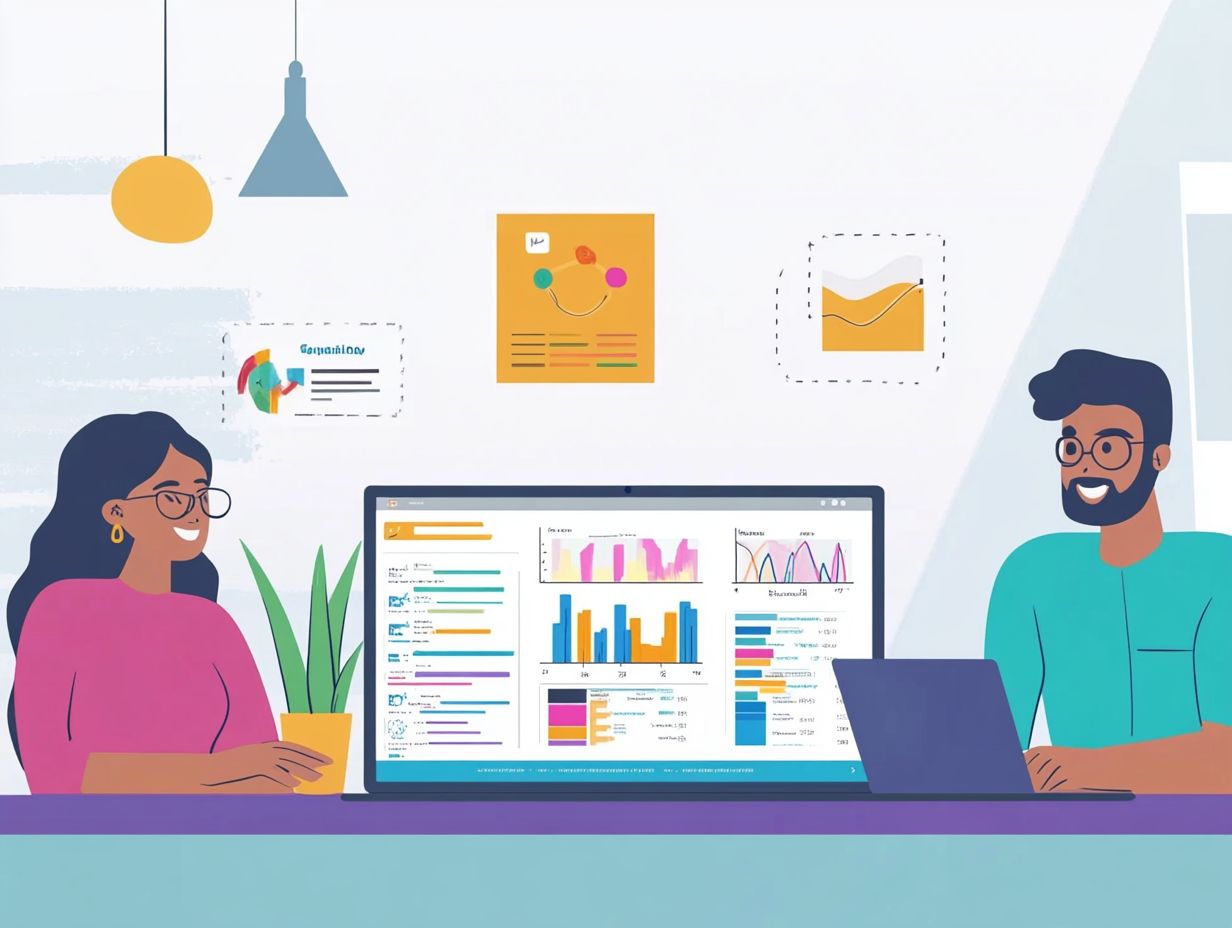In the evolving landscape of the digital age, Customer Relationship Management (CRM) systems are undergoing significant transformations with the integration of artificial intelligence and machine learning. By 2025, these systems are expected to emphasize integration, mobile accessibility, and automation, all aimed at enhancing efficiency and the overall user experience, including personalization and predictive analytics.
As data analytics and customer segmentation become increasingly vital, understanding how they interact is essential for success. In this article, we explore the key CRM features set to redefine the future, including multi-channel communication and task automation, ensuring your business remains competitive and focused on meeting customer needs. Let us guide you through the innovations that will help you stay at the forefront of customer engagement.
What are the essential CRM features for businesses in 2025?
Looking ahead to 2025, the role of Customer Relationship Management (CRM) systems is changing, and businesses must adapt to stay competitive. A well-equipped CRM will streamline operations and improve customer relationships through automation, strong data security, advanced analytics, and effective contact management.
Key features like user-friendly interfaces, mobile access, and easy integration with existing tools are crucial for enhancing customer service, managing leads, increasing efficiency, and ensuring system compatibility. Understanding these CRM features is essential for businesses aiming to succeed during digital transformation, utilizing tools such as CRM software integrations and scalability options.
In 2025, advanced automation tools will help streamline lead management and lead scoring, allowing teams to efficiently prioritize leads. A user-friendly interface will be increasingly important as it enables employees to easily navigate complex data without needing extensive training, supported by comprehensive training resources and onboarding processes.
With rising cyber threats, ensuring top-notch data security in CRM software is essential to protect sensitive customer information, in line with industry compliance standards. The ability to generate insightful analytics from customer interactions will help businesses make informed decisions, strengthen customer relationships, and boost sales through effective customer journey mapping and segmentation strategies.
How can AI integration enhance CRM functionalities?
Integrating AI into CRM systems is changing how businesses interact with customers and improve operations. AI enhances CRM features by offering intelligent automation for real-time data analysis and customer insights, improving sales forecasting, lead management strategies, and facilitating workflow automation and task management.
This boosts user experience and helps teams use predictive analytics for better decision-making and tracking, while also enhancing reporting capabilities and performance metrics analysis.
AI’s advanced algorithms analyze historical data to identify patterns and trends, allowing businesses to anticipate customer needs and leverage customer feedback. This leads to more personalized interactions, improved customer retention rates, and better support for customer-centric strategies.
Automating routine tasks reduces the need for manual work, letting staff focus on strategic goals rather than administrative tasks, thereby boosting productivity and enhancing user engagement.
AI-driven chatbots and virtual assistants further improve user experience by providing immediate support and tailored recommendations, creating a more engaging and responsive client environment with improved customer support and stakeholder engagement.
Why is mobile accessibility a crucial feature for CRMs in 2025?
Mobile accessibility is becoming crucial for CRM systems as businesses aim for flexibility and efficiency. By 2025, a mobile CRM allows users to access customer data and manage relationships on the go, ensuring teams stay productive and responsive wherever they are, with seamless cross-platform functionality and real-time updates.
This improves the use of CRM systems and enhances customer service and real-time data use, leading to better collaboration and engagement tracking, supported by efficient collaboration tools and workflow efficiency improvements.
With features like omnichannel support, these systems let users interact seamlessly across various platforms, such as social media, email, or live chat, ensuring no customer interactions are missed, facilitated by effective social media integration and email marketing capabilities.
Integration with tools like Slack or Microsoft Teams enables real-time communication among team members, allowing them to quickly share insights and updates, optimizing performance and improving team productivity with advanced productivity tools.
For example, a sales representative can update a lead’s status on their mobile device during a meeting, making this information immediately available to marketing and support departments for a unified customer engagement approach, enhancing pipeline management and lead nurturing efforts.
As a result, businesses are experiencing improved teamwork and a stronger focus on customer satisfaction.
How does automation improve CRM efficiency and user experience?
Automation greatly improves efficiency in CRM systems, changing how businesses handle customer interactions and internal processes. By using workflow automation, organizations can simplify repetitive tasks, improve task management, enhance user experience, and optimize performance with streamlined task automation.
This approach not only improves sales activity tracking but also provides valuable data insights for strategic decisions and customer engagement, supporting business intelligence and competitive analysis.
Automation improves task management by seamlessly assigning and tracking responsibilities, allowing teams to focus on high-impact activities instead of manual processes, facilitated by effective project management integration and improved user permissions management.
Additionally, automated workflows ensure timely follow-ups, enhancing customer satisfaction and increasing conversion rates. With real-time sales tracking, organizations gain immediate visibility into their pipeline, making it easier to identify trends, monitor performance, and adjust based on data-driven sales insights and reporting tools.
Adopting automation in CRM supports a more responsive and effective way to manage customer relationships.
What role does data analytics play in modern CRMs?
Data analytics is central to modern CRM systems, giving businesses the tools to gain actionable insights about customers and improve strategic decisions, supported by effective data management and reporting tools capabilities.
With advanced reporting and performance tracking, organizations can use predictive analytics to anticipate customer needs and enhance their relationship management strategies, supporting customer journey mapping and customer insights generation.
Data visualization tools help in understanding complex information, leading to better business intelligence and improved feature updates analysis.
By using large amounts of customer data, businesses can create personalized experiences that connect with their audience. For example, a retail company might examine purchase histories to predict future trends, ensuring they stock the right products at the right times, enhancing personalization strategies and boosting customer loyalty.
These insights help companies design more effective marketing campaigns, boosting conversion rates. Predictive models can spot customers at risk of leaving, enabling proactive strategies to maintain those relationships and improve customer retention through effective marketing automation.
Incorporating data analytics into CRM not only strengthens customer connections but also promotes business growth and scalability, supported by strategic CRM trends analysis and business intelligence advancements.
How important is customer segmentation in CRM features?
Customer segmentation in CRM systems helps businesses customize their marketing strategies and boost customer engagement. By targeting specific audiences and tracking their interactions, organizations can craft personalized communication that appeals to various customer groups, using effective segmentation strategies and lead management tactics.
This approach allows for more efficient resource use and strengthens client relationships. By identifying diverse customer categories, businesses can deliver tailored content, leading to better user experiences and higher response rates, leveraging CRM software for improved client relationship management.
Marketing automation aids in precisely reaching specific demographics, ensuring messages align with individual preferences and behaviors. As a result, businesses can run more efficient campaigns and build loyalty and trust with their customers, crucial for long-term success, supported by effective customer-centric approaches and stakeholder engagement.
What are the benefits of integrating CRM with other business tools?
Integrating CRM systems with other business tools offers significant benefits for improving workflow efficiency and team collaboration. By using third-party integrations, organizations can connect their CRM with cloud-based applications, ensuring smooth data flow and better data security through robust security protocols. This integration streamlines processes and meets industry standards, providing API integrations for customization to meet unique business needs.
For example, integrating a CRM with project management tools can automate task assignments based on customer interactions, saving valuable time and enhancing task automation and pipeline management capabilities.
Using specialized integration platforms also enhances data security protocols, protecting sensitive customer information from potential breaches and supporting data privacy and industry compliance.
The use of third-party tools allows businesses to customize CRM functionalities to specific workflows, such as marketing automation or customer support ticketing systems. This improves productivity and enhances the customer experience with a more precise and responsive approach, supporting effective user adoption and implementation support.
How does customization impact CRM usability for different businesses?
Customization is crucial for improving CRM usability across different business environments and meeting the unique needs of various organizations. A CRM system with extensive customization options can significantly enhance user experience by providing tailored access to relevant information and tools for different user roles. This flexibility helps with scalability and offers important training resources, including vendor support and pricing strategies, for effective CRM implementation.
A well-customized CRM allows sales teams to prioritize leads and marketing departments to efficiently segment campaigns, streamlining workflows and boosting productivity, supported by effective sales automation and CRM trends analysis.
For customer service representatives, easy access to key customer data ensures faster resolutions and more personalized interactions, while managers benefit from real-time analytics to guide strategic decisions, enhancing user interface and dashboard functionalities.
Overall, tailored systems increase user engagement, encourage collaboration across departments, and support growth, allowing businesses to refine their processes to meet changing demands, supporting effective feature updates and deployment options.
What security features should you consider in a CRM for 2025?
As data security becomes increasingly important, choosing a CRM for 2025 requires a careful review of its security features. A strong CRM system must follow industry regulations like GDPR, protecting customer data with advanced security measures and ensuring data privacy. Good support services and integration capabilities are also essential for ensuring user adoption and securing sensitive information through effective plugin support and system compatibility.
Organizations should prioritize CRMs that offer end-to-end encryption, regular security updates, and comprehensive authentication protocols to protect against unauthorized access, ensuring data security and industry compliance.
Clear documentation of compliance practices shows a commitment to transparency and responsibility, which can greatly enhance client trust and customer loyalty.
Evaluating the responsiveness of support services is also critical; effective help desks can resolve issues, provide customer support, assist with regulatory audits, and ensure users feel confident in the platform’s security and performance optimization.
By focusing on these key factors, businesses can create a secure and compliant environment that fosters customer loyalty, operational efficiency, and business growth.
How can a user-friendly interface affect CRM adoption rates?
A user-friendly interface is crucial for encouraging CRM adoption among team members. An intuitive and accessible CRM design fosters engagement, improves user experience, and increases the likelihood of users fully utilizing features like performance metrics and engagement tracking.
With mobile access, a user-friendly CRM allows team members to manage customer relationships efficiently from anywhere, leading to better business outcomes and greater scalability.
For example, a case study by a major SaaS company showed that after implementing a CRM with a streamlined interface, user adoption increased by over 30% within six months. Employees reported that the appealing dashboard, customization options, and easy navigation significantly reduced the learning curve, allowing them to focus more on customer interactions rather than struggling with complicated software.
This increased engagement not only boosts productivity but also creates a more positive attitude towards using the CRM, as team members feel competent and enabled. Organizations that use user-centric designs and incorporate feedback from customer insights often see improved customer satisfaction ratings, highlighting the significant impact of an effective interface on business success.




